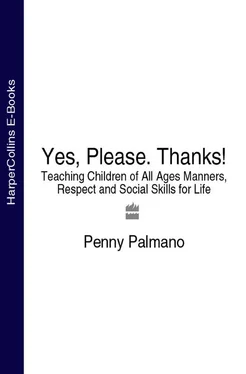
The sooner you start the easier it is.
Manners and Respect in the 21st Century – Why We Still Need Them
Manners, respect and simple courtesies should be second nature to everyone. They should not be considered as some sort of optional extra, as if we were deciding whether to have an electric sun-roof or tinted glass in a new car. They are as important as the steering wheel! And manners are not just about saying ‘please’ and ‘thank you’; they show a consideration for our fellow man and are a condition of a civilized society. They are the oil that smoothes the machinery of society.
The acid test of our children’s behaviour is how others perceive it. Their social education is as important as their academic one. As someone once said, manners are worth another A-level. You are actually disadvantaging your children if you don’t teach them, so come on, put in that time and effort. After all, don’t they deserve the best?
two
How the Wrong Foods Can Affect Children’s Behaviour, Health and IQ
There’s no point trying to teach your children how to behave when the food and drink they are consuming are working against you both. It’s like wanting a good night’s sleep but drinking a gallon of Turkish coffee an hour before bedtime! It simply isn’t going to happen.
Most children eat far too many fast-food products, pre-prepared meals, processed foods, fizzy drinks, snacks, sweets, biscuits and cakes, and almost all of these products may contain some type of food colouring, preservative, salt and sugar. These additives are a kind of ‘food makeover’, disguising poor nutritional food with colour and artificial flavour to make it more attractive to children.
But the increased consumption of these foods and the decline in the foods which are good for children, such as fresh vegetables, fruit, fish, meat and cheese, has sadly begun to take its toll. Hyperactivity, moodiness, obesity, long-term health problems and poor intellectual performance can all be connected to a poor diet.
For years, parents have voiced their concern about the possible link between food colourings, preservatives and behavioural changes in their children, but the food manufacturers and government have been constantly dismissive, claiming their theories lacked scientific evidence.
However, results from the first UK government-sponsored study have shown that children who were given colourings and preservatives were reported by their parents to be ‘fiddling with objects’, ‘disturbing others’, and having ‘difficulty settling down to sleep’, ‘difficulty concentrating’ and ‘temper tantrums’.
The researchers further claimed that if the problem additives and preservatives were removed from children’s diets, hyper-activity would be reduced from 1 in 6 children to 1 in 17.
In this health-conscious, diet-addicted era in which we now live, during the past ten years there has been a 70 per cent increase in obesity among three-and four-year-olds. Obesity in three-to four-year-olds? If this doesn’t ring alarm bells, what will? And if that isn’t scary enough, it is now recognized that obesity leads to increased risk of heart disease and diabetes.
The cause is quite simply a poor diet and lack of exercise.
Although children enjoy eating crisps, sweets, snacks and processed foods, and however quick and convenient they may be for the parents, these foods are the worst culprits.
Too much salt will withdraw calcium from the body which children urgently need to develop strong bones, teeth and nails. It will also increase the risk of osteoporosis, asthma, stroke, heart attack, water retention and raised blood pressure in later life.
The maximum recommended intake of salt per day is:
| 0–6 months |
less than 1mg |
| 7–12 months |
1g |
| 1–3 years |
2g |
| 4–6 years |
3g |
| 7–10 years |
5g |
| 11–14 years |
6g |
An average 7–10-year-old’s daily diet may include:
| Breakfast |
40g cornflakes |
1g |
| Lunch |
Ham sandwich (white bread) |
1.85g |
|
Processed-cheese portion |
0.50g |
|
Packet crisps |
0.50g |
| Snack |
2 chocolate biscuits |
0.33g |
| Supper |
Children’s portion pizza |
4.1g |
|
Portion chips |
2g |
| Total Salt Intake |
|
10.28g |
That is over twice as much as the recommended allowance and does not include any salt added at the table.
Most food packaging says how much sodium is in the product. To calculate how much salt that is, multiply the amount of sodium by 2.5. Example: 1g sodium = 2.5g salt.
For years we have known that sugar has disastrous effects on children’s teeth and contributes towards obesity. But it is also a stimulant which affects children’s blood-sugar levels, producing short bursts of energy or hyperactivity followed by an immediate low, which can manifest itself in moodiness or difficult behaviour and a craving for more sugar.
The brain chemicals which affect people’s moods, including depression, are called serotonin and beta endorphins. Doctors now believe that there is a direct link between glucose (what pure white sugar breaks down into in our bodies) and these chemicals.
An excess of white sugar can change the normal biochemical ‘pathways’ of both, resulting in moody, unmanageable and disruptive children who make everyone’s life a misery, including their own. Products made mainly from pure white flour will also convert into pure sugar in the body with the same effect.
A can of cola contains both sugar and caffeine, combining two stimulants. If children drink a can at lunchtime the caffeine will still be in their system by the evening and we know what that means – T-R-O-U-B-L-E. These poor children will not be able to sit still at school or around the dinner table and will find it difficult to fall asleep. Be on the safe side and avoid all sugary foods at suppertime, offering fruit as an alternative dessert or snack.
To reduce children’s intake of sugar take the sugar bowl off the table and be in charge of the amount they can have. Gradually reducing the sugar on their cereals and in their diet will go unnoticed but will make a significant difference to their overall consumption.
Schools that have removed vending machines selling sugar-laden snacks and drinks and replaced them with fresh fruit and water or fruit juice have reported that attention rates have improved and that problem children are much calmer as a result.
Give your children fresh or dried fruit, water and juices (check the sugar content) as snacks and leave the sweet snacks and drinks for the odd occasion or use them on a reward basis occasionally. As an alternative to canned fizzy drinks, dilute fruit concentrates with a fizzy mineral water. Your children’s tastes will adapt to their healthy diet and although they will still enjoy sweet products they will find many unnaturally sweet.
Читать дальше













